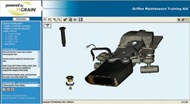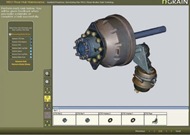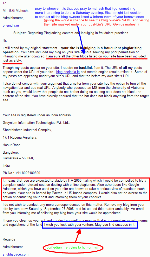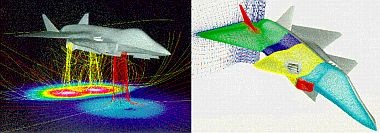The need to be provided with easily comprehended, accurate data in a timely manner is of absolute imperative when on a developmental pursuit of the magnitude of the Joint Strike Fighter [JSF] program. The scale of operation of the Joint Strike Fighter program is such that it is bound to generate a gargantuan amount of data that needs to be accessed by hundreds of concerned individuals situated in disparate geographical locations.
Equally important is the fact that this data must be accessed in a manner that is easily comprehended by the seeker and it must leave no room for misinterpretation that could possibly result in costly losses. Any change in the value or nature of the data must be reflected accurately and instantly all across wherever that data is accessed so that it can be taken into account while taking decisions. Efficient management of the generated data and maintaining its integrity is thus of paramount importance in ensuring the success of the JSF program. Taking this end into consideration, the data management and transfer is handled by what has now come to be known as The Digital Trail.
The digital thread is in essence an interlinking arrangement where the suite of software solutions being used for the Joint Strike Fighter program have access to a common, central information database from which it can both retrieve and submit data which can then be accessed by the other softwares as and when needed by them. Data generated at each step of the developmental process in the JSF program is automatically updated into the database, that then makes it available for access by anybody who seeks the data. This digital information database ensures that any change in value of the data is duly and accurately reflected at all points of access. Thus the seeker receives up-to-date and accurate information, that enables him/her to take the appropriate decision involving that data. By linking the various softwares involved, it is possible to transfer the same generated data from one software package to another. Thus the name Digital Trail. Digitized data also ensures data integrity. This data that is generated by the design engineers would be used through the entire life-cycle of the aircraft. The goal is to reuse the original data without having to reproduce it manually that would increase the chances of errors creeping in.
The backbone of this Digital Thread is the Product Lifecycle Management [PLM] software solution deployed to handle the generated data and co-ordinate a collaborating network on a global scale. It has been estimated that the approximately 1.5 million parts aircraft has generated around 20 Terabytes of data till date and is only expected to increase with time, thus requiring a robust scalable platform. This increasing product database will have to be managed through the estimated 50 year lifecycle of the aircraft. To manage this data, the JSF team had acquired the Metaphase Enterprise Software developed by the Structural Dynamics Research Corporation [SDRC]. This has since been upgraded to the latest Teamcenter 2005 Product Lifecycle Management Software developed by the Unigraphics Corporation [which acquired SDRC and renamed the product to Teamcenter Enterprise, which has since itself been acquired by Siemens]. The Joint Strike Fighter program currently uses around 13500 licenses of the Teamcenter solution.
The objectives of the PLM software in the JSF program is even more stringent and challenging considering that it has to handle data requisition of partners from different countries. While providing them with the data round the clock 24/7, the software ensures that the data provided pertains only to that part of the program in which the partner is involved and must be in conformance with US regulatory laws like the International Traffic in Arms Regulation (ITAR) as also protection of Intellectual Property Rights [IP].
Yet another challenge the PLM software addresses is coordinating the manufacturing of the various sub-assemblies at different locations which would then be brought to the Final Assembly and Checkout [FACO] line at Forth Worth, Texas and in future Italy and UK where FACO lines are proposed to be set up. It results in quicker assembly time as they are being assembled in tandem as opposed to sequential assembly. This is a marked deviation from the earlier practice of assembling the whole aircraft from start to finish in one location. It drastically increases the number of parameters the software has to monitor and keep track of while ensuring the smooth functioning of the process. Efficient and effective interaction with the supply chain to provide the right part at the right time in the right quantity at the right location has to be effectively tackled by the PLM solution. Some of the other tasks the solution performs include managing multiple bills-of-materials, material specifications, parts catalogs, detailed product geometry created by multiple computer-aided design (CAD) systems among others.
Such requirements, when there is a large amount of overlapping of interests, demands a PLM solution that performs at the absolute best. Effective use of the PLM solution through the developmental phase of the aircraft brought about a saving of around $62 million USD. It would not be inappropriate to say that the JSF program is changing the way one would expect PLM to function and lessons learned here would find application in PLM solution deployment in other industries.
The aircraft has been designed completely in solid model using the Catia V4 and V5 packages developed by Dassault Systèmes which were run on Silicon Graphics Octane2 and Silicon Graphics Fuel workstations. Silicon Graphics Visual Workstations along with Onyx2 systems and Origin 2000 servers were used for simulation and analysis. Besides achieving an accurate, detailed representation of the aircraft to be built, this also ensured that each and every point on a designed part has been referenced accurately with respect to the other points on the part in a 3-D space. The relative positions of each and every point of the part is available in a digital format. This helps CNC-controlled machine tools to accurately orient the tool with reference to the component surface. As a result, parts can be accurately machined to extremely close tolerances using the CNC machine tools interfaced with the software. This would not have been easily achieved earlier. The high quality of machining achieved is quite effectively reflected by the fact that almost no 'traveled work' is needed on a part, i.e., a part that is manufactured and brought to the final assembly location does not need a rework at the final assembly plant before mating it with other components. This digital definition of the product will then be used through the entire lifecycle of the product – tooling, manufacturing, assembling as well as support.
![Catia Netaphase Interface [CMI] developed by T-Systems Catia Netaphase Interface [CMI] developed by T-Systems](//lh6.ggpht.com/shubhpicasa/SLz9Mg5PtjI/AAAAAAAAA1Q/2uAZSWHdH74/20080901f35jsf04%5B6%5D.jpg?imgmax=800)
Yet another evidence of the Digital Thread and its associated benefits - the JSF team directly transfers data from its Teamcenter Enterprise product management system into CATIA and vice versa. This enables data generated by Teamcenter to be visually represented with ease in CATIA without resorting to cumbersome, time consuming, manual data transfer. This also aids the accuracy of data transferred. This seamless integration and transfer of data has been made possible using the commercially available Catia Metaphase Interface [CMI] system developed by T-Systems, which has since been customized to cater to this program.
The Virtual Product Development Initiative [VPDI] of Lockheed Martin aimed to create a complete virtual environment for designing and testing the aircraft. Its objective was to create a platform where design testing and analysis of the aircraft could be performed in a virtual environment, based on which subsequent design iterations too could be made and tested in the same environment. This would do away with the need to create a physical model to test the initial iterations and thus push the creation of the physical model right to the end when in the process of final design validation. It aimed to provide everyone involved in the product definition with the relevant information and latest version of sought data and a platform to collaborate their efforts without being hindered by the distance of their physical location.
It has acquired licenses to use Deneb Robotics Inc's simulation software to test and validate its manufacturing and maintenance process in a virtual environment before implementing it on the floor. This virtual environment is being used to simulate the different aspects of JSF design, manufacturing and support which allows the team to detect any flaws and bottlenecks in the process that can be sorted out before being actually physically set up.
By interfacing it with Catia, it achieves a seamless process of both design and process testing as the designed models can now be easily transferred from Catia into Deneb's solution and its result transferred back into Catia for action to be taken if necessary. Lockheed Martin says that this has reduced cost for production, development and support by 70% to 80% in some areas as also the total cycle time.
Some other software solutions deployed by Lockheed Martin as part of the VPDI initiative include Engineering Animation's [since renamed to Demonstratives Inc.] VisFly solution, that let its Engineers situated in geographically separated locations to collaborate with one another using virtual models in real-time. It also used the company's VisMockUp and VP/Sequence solutions to evaluate models and analyze the parts manufacturing and installation.
 This digital thread is being tapped into for preparing an accurate, standardized training and maintenance system for the aircraft. As part of the Joint Strike Fighter's Autonomic Logistics Information Systems (“ALIS”) program, NGRAIN was awarded a contract is to provide them with a customized version of its 3-dimensional performance support solution. Using this software, any fault detection or repair work that needs to be carried out can be conveniently marked on a virtual 3-D model of the aircraft, which can then be sent over to the concerned personnel instantly for corrective action to be taken. It would be of no consequence even if the person to whom the information is being transferred to is located across the continent. Thus one would be able to completely do away with the cumbersome, time consuming and error-prone practice of filling up paper reports that
This digital thread is being tapped into for preparing an accurate, standardized training and maintenance system for the aircraft. As part of the Joint Strike Fighter's Autonomic Logistics Information Systems (“ALIS”) program, NGRAIN was awarded a contract is to provide them with a customized version of its 3-dimensional performance support solution. Using this software, any fault detection or repair work that needs to be carried out can be conveniently marked on a virtual 3-D model of the aircraft, which can then be sent over to the concerned personnel instantly for corrective action to be taken. It would be of no consequence even if the person to whom the information is being transferred to is located across the continent. Thus one would be able to completely do away with the cumbersome, time consuming and error-prone practice of filling up paper reports that  needs to be forwarded manually to achieve the same end result. This solution would be customized for installing on to portable devices carried by the aircraft maintenance personals, thus giving them easy access. Similarly, aircraft assemblers would be provided with a 3-dimensional representation of that portion of the aircraft that he would be working on along with all the necessary information neatly represented on it. This would greatly simplify the worker's understanding of the instruction, resulting in improvement of his work performance. The ALIS program is expected to reduce support cost by 20% compared to practices adopted for legacy aircrafts. Implementing the Autonomic Logistics Information Systems would also reduce training time of personnel's by 60%, thanks to the easy to understand 3-dimensional training system developed using NGRAIN's solutions.
needs to be forwarded manually to achieve the same end result. This solution would be customized for installing on to portable devices carried by the aircraft maintenance personals, thus giving them easy access. Similarly, aircraft assemblers would be provided with a 3-dimensional representation of that portion of the aircraft that he would be working on along with all the necessary information neatly represented on it. This would greatly simplify the worker's understanding of the instruction, resulting in improvement of his work performance. The ALIS program is expected to reduce support cost by 20% compared to practices adopted for legacy aircrafts. Implementing the Autonomic Logistics Information Systems would also reduce training time of personnel's by 60%, thanks to the easy to understand 3-dimensional training system developed using NGRAIN's solutions.
The program has additionally deployed Visiprise's process-management and manufacture change management solutions in order to cater to the demands of the Joint Strike Fighter program.
Lockheed Martin recently awarded SAP AG to provide its ERP solution for the JSF program. This task was earlier being handled by its own custom-made Production & Inventory Optimization System (PIOS). SAP's solution would offer better integration of the ERP with the digital thread than its current system.
Even the task of painting the aircraft body would be making use of the digital thread. Using Delmia's simulation software [Delmia has since been acquired by Dassault Systèmes], CTA Inc, the system integrator appointed for the job, intends to program and simulates the paint job process of the aircraft before giving instructions to the machine. Based on aircraft geometry and plant layout, it would check for any potential obstructions in the arm's trajectory and optimize the path followed to apply an even, good quality coat of paint without wastage. The simulation would be able to take into account multiple robotic arms, use of fixtures and material handling devices that would be used in the painting process. Delmia's software suite consists of the IGRIP resource modeling and simulation software with UltraPaint option. The IGRIP is also being used to simulate the clamping and joining of drilled components in the assembly of the aircraft. The latest Catia models are made available to these simulation solutions to generate the most accurate results.
The Joint Strike fighter development program employs a host of software solution performing various tasks. By performing major tasks and operations in a virtual environment and linking the numerous softwares involved to share data among one another, the JSF program develops a truly unique platform for product development and data sharing.
----------------
PS: I am in the process of compiling my sources. Will post it as soon as I complete it.






 If you are an Auto fiend and an Engineer(-ing buff), then the articles published in this month’s
If you are an Auto fiend and an Engineer(-ing buff), then the articles published in this month’s 







![Catia Netaphase Interface [CMI] developed by T-Systems Catia Netaphase Interface [CMI] developed by T-Systems](http://lh6.ggpht.com/shubhpicasa/SLz9Mg5PtjI/AAAAAAAAA1Q/2uAZSWHdH74/20080901f35jsf04%5B6%5D.jpg?imgmax=800)

